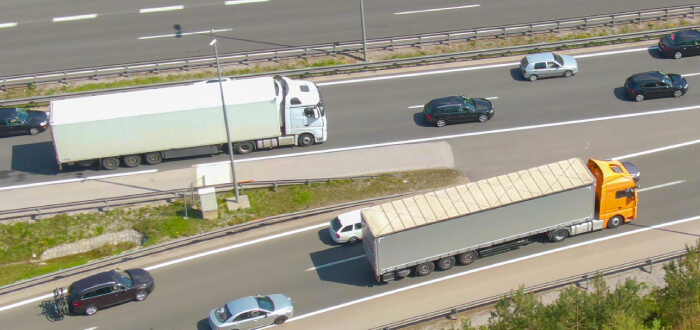Driving near a large commercial truck can be intimidating, especially when you’re in a smaller vehicle.
Semi-trucks are big, heavy machines, and even a minor collision with one can have devastating consequences. To make matters worse, they tend to feature more significant blindspots than most other vehicles on New York roads due to their oversized dimensions.
As such, it’s vital to use caution whenever you encounter a truck.
Blindspots Explained
The most critical aspect of driver visibility affected in larger vehicles is known as “line of sight.” This term refers to the geometrically visible area a motorist can see while driving, including the furthest and widest distances.
Blindspots are the areas directly around a vehicle that a motorist cannot see. These are often created by visibility-affecting factors such as sharp angles, mirror placement, window placement, and seat height.
Whenever cars, bicycles, or even pedestrians enter into blindspots, truck drivers can unknowingly become involved in a collision, and the results can sometimes be dangerous, and even fatal. Because of the dangerous nature of blindspots, you should always do your best to keep a reasonably safe distance when driving near a truck.
Common Blind Spots on Commercial Vehicles
Blindspots on passenger cars vary greatly and are often minimal, but trucks and other oversized vehicles share more dangerous blind spots.
Fortunately, spatial awareness and defensive driving techniques can help prevent fatal accidents. Here are some of the most common blind spots on commercial trucks that you should know about.
Directly Behind the Truck
Semi-trucks are long and wide. Depending on their unique set-up, a trailer may be over 100 feet long and carry loads upwards of 80,000 pounds.
Because of their shape and size, the zones directly behind a truck are often obstructed. And unlike cars or buses equipped with a rearview mirror, semi-trucks only have side mirrors. As such, it’s important to remember that any area directly behind a truck will likely be out of the driver’s line of sight.
Directly in Front of the Truck
The area directly in front of a commercial truck is also susceptible to blind spots due largely to the truck’s design.
Considering how far out a commercial truck’s nose stretches out, you can imagine how challenging it can be to see right under this area. Because drivers must sit high up, smaller objects can easily go unnoticed.
Most experts agree that truck drivers have limited visibility up to 25 feet in front of their vehicles.
Both Sides of the Truck
It can be difficult to avoid driving alongside commercial trucks, especially in dense traffic. However, it’s important to note how dangerous these areas can be.
In many cases, the zones closest to the truck’s body disappear from the driver’s line of sight along the flanks. Even trucks equipped with aftermarket side mirrors can fail to display small objects that enter into these blind spots. Additionally, the driver’s and passenger’s sides each have varying levels of visibility.
When driving in heavy traffic, be careful not to get too close to the sides of a truck, and try to maintain a safe distance so the driver can see your vehicle at all times.
Under the Driver’s Side Window
Commercial semi-trucks are often two or three times the height of a typical car. Because drivers sit so much higher, their visibility suffers in the areas directly underneath their windows. Consequently, whereas truck drivers may be fine seeing straight ahead, they can struggle to see what’s below window level.
Long Island Truck Accident Attorneys
Commercial truck drivers have a duty of care to follow the rules of the road. Negligent behavior can cause traffic accidents, sometimes with life-threatening consequences.
Kohan Law Group represents personal injury clients throughout Nassau County, New York, as well as New York City, Suffolk County, and Westchester County. If you’ve been injured by a truck driver, contact us today for a free consultation.

